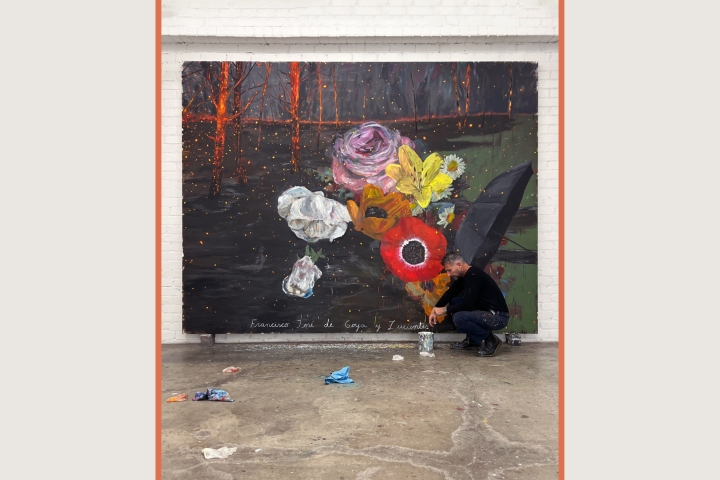The artist Enrique Martínez Celaya began reading the poetry of Robert Frost when he was a teenager, wrestling with questions of existence, identity and his place in the world.
Born in Cuba, and raised in Spain and Puerto Rico, Martínez Celaya lives in Los Angeles; Frost was California-born, but his life and work were rooted in Massachusetts, where he grew up, and New Hampshire and Vermont, where he later lived and owned property.
As an adolescent Martínez Celaya didn’t know in any literal sense the physical or historical worlds Frost described, but he grasped Frost’s direct, conversational language and the welter of emotions hidden in plain sight—what the mid-century literary critic Alfred Kazin called Frost’s “perilous balances and unyielding memories.”
Martínez Celaya’s long engagement with Frost is at the heart of the exhibition The Grief of Almost, which opens at the Hood Museum of Art on June 8 and runs until April 2025.
To generations of older Americans, Frost, who briefly attended Dartmouth as a student, is best known for his poem Stopping by Woods on a Snowy Evening, which made him eternally famous but also reduced him, perhaps, to a piece of folksy rural Americana, the wise old grandfather speaking in epigraphs, albeit one who won four Pulitzer Prizes for poetry.
But for Martínez Celaya, Frost’s work is “an inexhaustible source of insights and understanding about the nature of art,” he says.
The Provost Professor of Humanities and Arts at the University of Southern California, Martínez Celaya studied physics as an undergraduate at Cornell University. He is a former Montgomery Fellow and Roth Family Distinguished Visiting Scholar at Dartmouth. His work has been exhibited and collected internationally, including the State Hermitage Museum in St. Petersburg, Russia; The Phillips Collection in Washington, D.C.; the Museo Nacional de Bellas Artes in Havana, Cuba; the Los Angeles County Museum of Art; and the Metropolitan Museum of Art in New York.
For some modernist artists, says John Stomberg, the Virginia Rice Kelsey 1961s Director of the Hood Museum, the formal qualities of their work—what something looks like—is the point. Martínez Celaya takes a different route.
“His brushstrokes, his colors, they all follow in pursuit of his metaphysics. He’s thinking about what nature and humans have in common and how they interact. I think there’s a great comparison to be made between his use of imagery and color, and Frost’s use of subject matter and language,” Stomberg says.
Jami Powell, the Hood’s associate director of curatorial affairs and curator of Indigenous art, and curator for The Grief of Almost, observes that “the series of paintings, and the installation as a whole, is really exploring these cycles of hope, catastrophe and redemption that characterize human life.”

Frost’s wife and four of their six children died before him, including a son who died by suicide in 1940 at age 37. In 1954 he told an interviewer, “In three words, I can sum up everything I’ve learned about life. It goes on.”
That spirit and ethos are central to the exhibition, which comprises paintings, objects and writing, But the show is not specifically about the poet’s biography and it’s not pedagogical, says Martínez Celaya. He thinks of the exhibition not as “a collection of objects but rather a collection of relationships that are animated when you walk in and spend some time with it.”
The exhibition is intended to be an immersive, participatory environment. And because it eschews explanatory wall labels, it asks audiences to “grapple with concepts like unknowing and ambiguity,” Powell says.
A large model of a small plane, which is painted black and pulls behind it a dead apple tree, will take up part of the exhibition space. Visitors will be invited to write poems or notes on small pieces of paper, and drop them into a collection box; staff will collect the notes and hang them on the tree; over time, the notes will look like leaves, bringing the apple tree metaphorically back to life.
Part of the pull for an Upper Valley audience, Martínez Celaya observes, is that the exhibition is at Dartmouth, where Frost matriculated in the Class of 1896 but left after less than one term. He later taught at Dartmouth as a Ticknor Fellow from 1943 to 1949 and spoke in the College’s Great Issues lecture series. The New Hampshire and Vermont landscapes today, although more developed, are not radically different in their nature than what Frost would have experienced.
“Frost has this history with the landscape. The landscape is a very important character in this exhibition. If the exhibition were in Florida it would lose a significant part of its power, I think,” says Martínez Celaya.
The Grief of Almost is notable, also, for its extended run. In the past, shows have typically run three months to limit the exposure of works of art to environmental stress, Powell says. The advantage of a longer exhibition for a teaching museum such as the Hood is that it gives faculty and students more time to look at and contemplate work. It also gives people on campus and off multiple chances to visit, Powell adds.
“One of the things we’ve found is that faculty who teach with work in one term learn a lot about what they want to teach with as the term goes on. At the end of three months you have a very different relationship with that show or object,” says Stomberg. “The Grief of Almost is the kind of show that will really grow richer as people engage with it over time.”
As part of the exhibit’s run, Enrique Martínez Celaya will give an artist’s lecture at the Hood Museum on Sept. 27 from 5 to 6 p.m.

